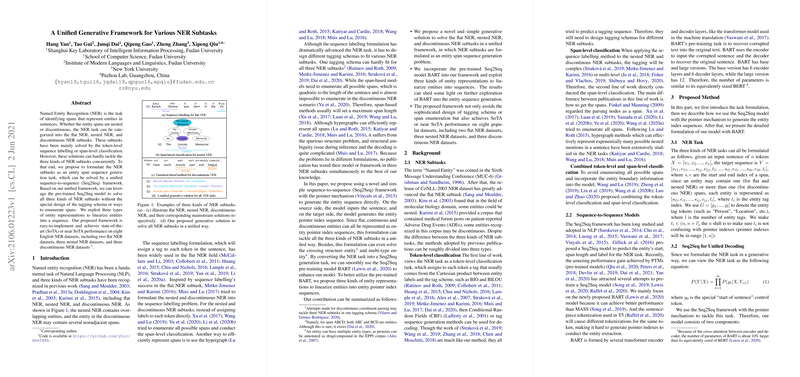A Unified Generative Framework for Various NER Subtasks: An Expert Overview
The paper "A Unified Generative Framework for Various NER Subtasks" introduces a novel approach to addressing the challenges in Named Entity Recognition (NER), a fundamental task in NLP. NER involves identifying entities within text, and it can be subdivided into flat NER, nested NER, and discontinuous NER. Traditional methods generally tackle these through token-level sequence labeling or span-level classification, which do not efficiently accommodate all three NER subtasks simultaneously. This paper proposes a unified solution via a generative framework that formulates the task as an entity span sequence generation problem using a sequence-to-sequence (Seq2Seq) model, mainly leveraging the pre-trained BART model.
Key Contributions and Approach
This work delineates the limitations of current NER modeling techniques and proposes converting the NER tasks into a Seq2Seq problem with a pointer mechanism, significantly simplifying the process. By utilizing BART—a robust Seq2Seq pre-training LLM—the authors demonstrate that it is feasible to generate entity representations directly from input sequences. Their framework does not require the complex tagging schemas or exhaustive span enumeration that previous models depend on, effectively mitigating the inefficiencies of traditional methodologies.
The research introduces three types of entity representations to linearize entities into sequences: Span-based, BPE-based, and Word-based pointers. These are crucial to leveraging BART's pre-training effectively, allowing the model to handle the translation between original textual representation and the entity index sequence.
Empirical Evaluation and Results
The proposed framework achieves state-of-the-art (SoTA) or competitive performance across eight English NER datasets, covering all three NER subtask variations. It demonstrates superior adaptability and consistency in performance, indicating its robustness and general applicability. This success lies in its innovative use of pre-trained Seq2Seq models without relying on specifically tailored NER tagging schemas or span enumeration techniques.
A detailed analysis of the results suggests that the Word-based and Span-based representations perform better due to their proximity to the pre-training objective of BART, which is geared towards generating coherent and contextually appropriate sequences. This outcome emphasizes the advantages of incorporating pre-training LLMs into task-specific fine-tuning sequences.
Implications and Future Directions
The implications of this research are significant. By providing a unified framework that effectively coordinates multiple NER subtasks, it simplifies the implementation of models for practical use cases without sacrificing performance. The approach has the potential to enhance NER systems' scalability and efficiency in various real-world applications, from information extraction to complex event representation.
Looking ahead, further exploration into integrating non-autoregressive model components could address the noted inefficiencies in decoding speed, especially during inference, which is currently conducted in an autoregressive manner. Additionally, research into extending this framework for multi-lingual NER tasks or employing it to other sequence prediction tasks could broaden its applicability and refine the generative sequence modeling landscape.
In summary, this paper contributes a cohesive and innovative approach to NER by harnessing generative modeling, marking a critical step forward in harmonizing NLP task-solving methodologies with pre-trained LLM capabilities.
